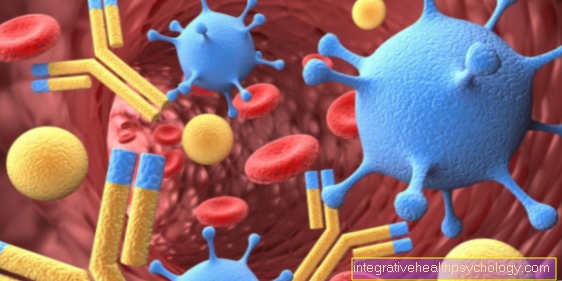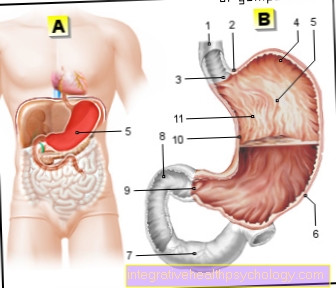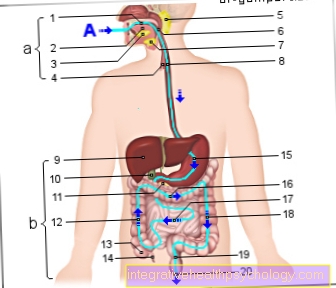Transmission of hepatitis B
What are the transmission routes of hepatitis B?
In principle, infection with hepatitis B is possible through any body fluid, as the virus, due to its small size, can basically get into the production facilities of all secretions. The most common way of infection worldwide is the transmission of the virus from mother to child during the birth process: After such an infection, the child almost always develops a chronic disease.
Read more on this topic: Symptoms of hepatitis B

In order to understand the different ways in which the hepatitis B virus is transmitted, it is best to first gain an overview of the occurrence of the virus in the body: The highest concentration of the virus is found in the bloodstream. Depending on the number of virus particles determined by the diagnostic tests, conclusions can be drawn about the occurrence of infectious virus particles in other body fluids: If a particularly large number of particles are found in the blood, it is a so-called highly viremic carrier, which the presence of particles in other secretions is very likely. Accordingly, such a person's body secretions are highly likely to be contagious.
Read more on this topic: Causes of Hepatitis B
Sexual transmission
The hepatitis B virus often occurs not only in the blood, but also in body fluids such as vaginal secretions or semen. Infection with the hepatitis B virus through sexual intercourse is therefore possible. Whether virus particles are actually present in the body fluids depends on the viral load of the infected person. If the blood contains a large number of virus particles (high viral load), contagious virus particles are likely to be present in other body fluids. If there are few viruses in the blood or a low viral load, infection through sexual intercourse is less likely, but still possible. The pathogens get through the smallest injuries in the skin or the mucous membrane, which cannot be seen with the eye, into the body and into the bloodstream.
As with many other sexually transmitted diseases, semen is also more infectious than vaginal secretions. This may explain why there are still many homosexual men among the reported cases of hepatitis B infection.
Transmission via saliva, tears or breast milk
As in many other body fluids, contagious virus particles can also be found in saliva, tear fluid and breast milk. This is particularly likely above a certain concentration of virus particles in the blood, but otherwise cannot be fundamentally excluded. These body fluids then need a portal of entry into the body to be infected, which usually consists of microscopic cracks or injuries in the skin or mucous membrane.
Anyone who has come into contact with the saliva or other body fluids of a possibly infected person and has not been vaccinated should consider seeing a doctor immediately.
Transmission by blood transfusion
The blood usually contains the relatively highest concentration of virus particles in the body of an infected person. Accordingly, contact with the blood of such a person is a major risk factor.
A blood transfusion with the blood or the blood product of a hepatitis B positive person would even bring this highly infectious material directly into the blood of the other person. Because of the high risk of infection with blood transfusions, the donor's blood is subjected to a variety of tests. Infection with hepatitis B through a transfusion with blood products is therefore highly unlikely.
Transmission probability
Concrete information for the sexual transmission probability is hardly possible. There are two main reasons for this: First, the occurrence of virus particles in sex secretions depends on the number of virus particles in the blood of the infected person. The amount of infectious particles in the body fluids is highly variable, as is the clinical picture that is caused. An infection does not necessarily have to result in acute, symptomatic hepatitis. In addition, the occurrence of hepatitis B infection has become extremely rare in Europe. Sexual transmission through protected intercourse has also become uncommon.
Transmission via saliva, tears or breast milk represent a less common possibility of infection. Far more infections are transmitted via needlestick injuries and during childbirth, as there is direct contact with infectious blood.
The route of infection by receiving a blood product is extremely rare. On the one hand, this is due to the thorough tests that the donated blood and the donor himself go through. In addition, the infected people usually belong to certain risk groups, which are excluded by querying certain factors before the blood donation.
Prevention
As with all sexually transmitted diseases, you protect yourself from contracting hepatitis B by having sex with a condom. This prevents the sperm or vaginal secretion from coming into contact with the other partner. However, this does not rule out infection through other body fluids, so theoretically infection through kissing can also occur. Oral sex is also a potential source of infection due to the contact of body fluids with the oral mucosa and should therefore not be carried out or not carried out without protection as long as the partner's disease status is unknown.
In general, care should be taken not to come into contact with the body fluids of an infected person. This may be easier with tears, but more difficult with saliva and breast milk. It is therefore advisable for (expectant) mothers to ensure that there is no infection.
To avoid contamination through saliva, it is usually sufficient to follow hygienic standards and avoid contact with the saliva of people at risk.
Vaccination against hepatitis B is recommended by the Standing Vaccination Commission and offers good protection against hepatitis B. Read more about vaccination against hepatitis B and the Twinrix® vaccine here.
Drug addiction
People who are addicted to drugs are known to have an increased risk of contracting HIV or a hepatitis virus. What is meant here is the use of intravenous drugs with unclean needles. Contact with the blood of a person infected with hepatitis B is relatively frequent (i.e. in around 30% of cases), while contact with other body fluids such as saliva or urine is less likely to result in infection.
This mainly depends on the number of pathogens in the blood of the infected person. If the number of pathogens is high, it is very likely that pathogens are also found in other body fluids. Infection through contact with saliva, tear fluid or the like, for example through sharing orally or nasally consumed drugs, is also possible. As a result, hepatitis B and hepatitis C are among the most common liver and infectious diseases among drug addicts.
dialysis
For people who depend on regular dialysis, there is a special vaccine with a higher concentration of active ingredients. This is due to the changed purification of the blood, through which the antibodies formed against the virus can be reduced more quickly. Despite the increased concentration of active ingredient in the vaccination, the vaccination is well tolerated. It is also possible to vaccinate with the conventional vaccine, but a different vaccination schedule is then recommended. It is best to consult your doctor in charge of this.
As with every vaccinated person, a titer check is carried out four to eight weeks after the vaccination in people who require dialysis, during which the antibody level is measured. In this way it can be checked whether the vaccination guarantees sufficient immunity. People who require dialysis are generally among those people who have an increased risk of contracting hepatitis B. Vaccination is therefore recommended for these people.
Is infection possible despite vaccination?
The vaccination stimulates the formation of antibodies in the body that render it harmless if it comes into contact with the hepatitis B virus. If enough of these antibodies were formed after vaccination, infection with this form of hepatitis is not possible. In rare cases, not enough antibodies are produced. One then speaks of so-called low-responders (few antibodies were formed) or non-responders (no antibodies were formed). Then an infection is theoretically possible.
To prevent such cases, a titer check is always carried out a few weeks after the vaccination. The number of antibodies formed is checked and, if there are too few antibodies, the vaccination is repeated.
How does viral load affect transmission?
Viral load is the concentration of viruses in a body fluid, usually the blood. It is given in IU (infectious units) per mL and is used as a measure of the infectivity, i.e. the contagion potential of a liquid: the more virus particles there are in the blood, the greater the risk of infection.
However, it should be added here that not all viruses with the same viral load are infectious or trigger a corresponding clinical picture. The hepatitis B virus is an example of a virus that can trigger hepatitis with very few virus particles, i.e. a low viral load. The viral load required is even lower here than with the HI virus, so the hepatitis B virus is highly contagious.





























